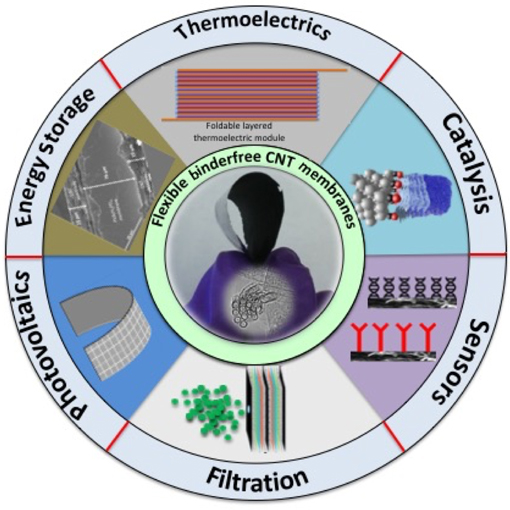Article contents
CNT flexible membranes for energy storage and conversion systems
Published online by Cambridge University Press: 24 April 2019
Abstract

We have successfully employed a charge transfer mechanism to convert carbon nanotube (CNT) powder into CNT flexible membrane with no binder. We have demonstrated the use of the CNT membranes as electrode in a stacked bipolar solid-state capacitor using grafoil as current collector that showed 80% capacitance retention over 10,000 cycles at 70 °C. The CNT membranes could have potential application in catalysis, photovoltaic, thermoelectric, and many others.
- Type
- Research Letters
- Information
- Copyright
- Copyright © Materials Research Society 2019
References
1.IPCC: Climate Change 2013: The Physical Science Basis. Contribution of Working Group I to the Fifth Assessment Report of the Intergovernmental Panel on Climate Change, edited by Stocker, T.F., Qin, D., Plattner, G.-K., Tignor, M., Allen, S.K., Boschung, J., Nauels, A., Xia, Y., Bex, V., and Midgley, P.M. (Cambridge University Press, Cambridge, United Kingdom and New York, NY, USA, 2013), 1535 pp., https://unfccc.int/Google Scholar
3.Dai, H.J., Javey, A., Pop, E., Mann, D., and Kim, W.: Electrical transport properties and field effect transistors of carbon nanotubes. Nano 1, 1–13 (2006).Google Scholar
4.Pop, E., Mann, D., Wang, Q., Goodson, K.E., and Dai, H.J.: Thermal conductance of an individual single-wall carbon nanotube above room temperature. Nano Lett. 6, 96–100 (2006).Google Scholar
5.Ruoff, R.S., Qian, D., and Liu, W.K.: Mechanical properties of carbon nanotubes: theoretical predictions and experimental measurements. C. R. Phys. 4, 993–1008 (2003).Google Scholar
6.Baughman, R.H., Zakhidov, A.A., and de Heer, W.A.: Carbon nanotubes - the route toward applications. Science 297, 787–792 (2002).Google Scholar
7.Yu, C.H., Shi, L., Yao, Z., Li, D.Y., and Majumdar, A.: Thermal conductance and thermopower of an individual single-wall carbon nanotube. Nano Lett. 5, 1842–1846 (2005).Google Scholar
8.Kim, P., Shi, L., Majumdar, A., and McEuen, P.L.: Thermal transport measurements of individual multiwalled nanotubes. Phy. Rev. Lett. 87, 215502/1–4 (2001).Google Scholar
9.Ng, S.H., Wang, J., Guo, Z.P., Chen, J., Wang, G.X., and Liu, H.K.: Single wall carbon nanotube paper as anode for lithium-ion battery. Electrochim. Acta 51, 23–28 (2005).Google Scholar
10.Futaba, D.N., Hata, K., Yamada, T., Haraoka, T., Hayamizu, Y., Kakudate, Y., Tanaike, O., Hatori, H., Yumura, M., and Iijima, S.: Shape-engineerable and highly densely packed single-walled carbon nanotubes and their application as super-capacitor electrodes. Nat. Mater. 5, 987–994 (2006).Google Scholar
11.Dresselhaus, M.S., Dresselhaus, G., and Eklund, P.C.: Science of Fullerenes and Carbon Nanotubes (Academic Press, San Diego, USA, 1995).Google Scholar
12.Jiang, L.C. and Zhang, W.D.: A highly sensitive nonenzymatic glucose sensor based on CuO nanoparticles-modified carbon nanotube electrode. Biosens. Bioelectron. 25, 1402–1407 (2010).Google Scholar
13.Zhang, C.H., Wang, G.F., Ji, Y.L., Liu, M., Feng, Y.H., Zhang, Z.D., and Fang, B.. Enhancement in analytical hydrazine based on gold nanoparticles deposited on ZnO-MWCNTs films. Sens. Actuators B-Chem. 150, 247–253 (2010).Google Scholar
14.Zhang, C.H., Wang, G.F., Ji, Y.L., Liu, M., Feng, Y.H., Zhang, Z.D., and Fang, B.: A hydroxylamine electrochemical sensor based on electrodeposition of porous ZnO nanofilms onto carbon nanotubes films modified electrode. Electrochim. Acta. 55, 2835–2840 (2010).Google Scholar
15.Rakhi, R.B., Sethupathi, K., and Ramaprabhu, S.: A glucose biosensor based on deposition of glucose oxidase onto crystalline gold nanoparticle modified carbon nanotube electrode. J. Phys. Chem. B 113, 3190–3194 (2009).Google Scholar
16.Snow, E.S. and Perkins, F.K.: Capacitance and conductance of single-walled carbon nanotubes in the presence of chemical vapors. Nano Lett. 5, 2414–2417 (2005).Google Scholar
17.Snow, E.S., Perkins, F.K., Houser, E.J., Badescu, S.C., and Reinecke, T.L.: Chemical detection with a single-walled carbon nanotube capacitor. Science 307, 1942–1945 (2005).Google Scholar
18.Chen, R.J., Zhang, Y.G., Wang, D.W., and Dai, H.J.: Noncovalent sidewall functionalization of single-walled carbon nanotubes for protein immobilization. J. Am. Chem. Soc. 123, 3838–3839 (2001).Google Scholar
19.Xu, B.X., Qiao, Y., Zhou, Q.L., and Chen, X.: Effect of electric field on liquid infiltration into hydrophobic nanopores. Langmuir 27, 6349–6357 (2011).Google Scholar
20.Rao, A.M., Bandow, S., Richter, E., and Eklund, P.C.: Raman spectroscopy of pristine and doped single wall carbon nanotubes. Thin Solid Films 331, 141–147 (1998).Google Scholar
21.Adu, K., Ma, D., Wang, Y., Spencer, M., Rajagopalan, R., Wang, C.Y., and Randall, C.: Flexible robust binder-free carbon nanotube membranes fo solid state and microcapacitor application. Nanotechnology 29, 035605/1–13 (2018).Google Scholar
- 3
- Cited by


